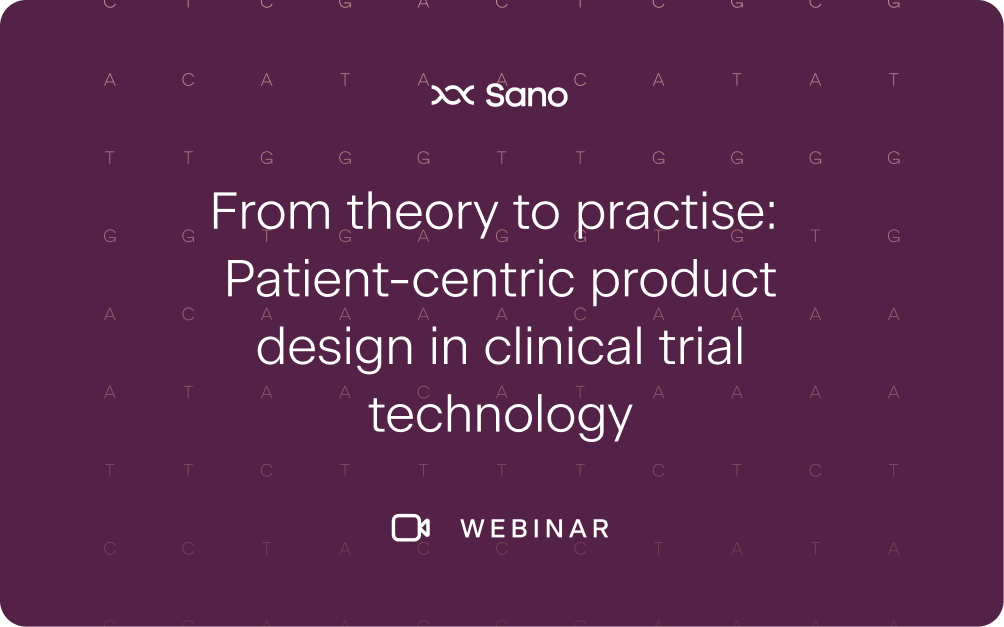Webinar recap: Patient-centric product design in clinical trial technology

In the recent webinar hosted by Jess Burrows, Product Designer at Sano Genetics, and Marisa Ngbemeneh, Product Manager at Sano Genetics, we took a deep dive into the importance of patient-centric design in healthcare. The conversation highlighted how prioritising the patient experience can significantly improve clinical trials and research initiatives.
The link to the full webinar is here; a brief summary is below for easy reference.
About the speakers
.png?width=289&height=291&name=Group%2048095551%20(1).png)
Jess Burrows
Jess Burrows is a talented UX/UI product designer with a passion for creating user-friendly solutions. She holds a degree from the University of Leeds and has extensive experience in building design systems and translating complex data into intuitive product experiences. At Sano, Jess ensures that all our products are designed with the patient's needs at the forefront.

Marisa Ngbemeneh
Marisa Ngbemeneh is an engineer-turned-designer and now a Product Manager at Sano. With a background in engineering from Columbia University, Marisa is dedicated to creating patient-centric clinical trial experiences. She’s passionate about working on projects that have a real impact, especially in healthcare.
Highlights from the webinar
Why patient-centric design matters
Jess and Marisa kicked off the webinar by explaining why patient-centric design is so important. It’s about making sure that patients are at the heart of everything we do, from product development to research initiatives. While this sounds simple, it’s actually quite complex in practice. The goal is to make personalised medicine and treatment options more accessible and effective for everyone.
How we implement patient-centric design
Jess then walked through our product design process at Sano, which starts with gathering data from our users and stakeholders. This data helps us understand the pain points and needs of our users. We then use this information to inform our design decisions. It’s a cyclical process that involves continuous prototyping, testing, and collaboration across different teams to ensure that patient needs are always at the centre of our work.
Case study: Improving the report upload process
Marisa shared a case study on how we improved the report upload process for genetic testing. By simplifying the language and providing clearer instructions, we reduced the number of participants dropping out of the process and ensured we received higher quality reports. This instance highlighted how small changes in design can have a big impact on user experience and data quality.
Spotlight on the Light the Way program
Marisa also introduced the Light the Way program, which is designed for individuals with genetic MND/ALS or a family history of the disease. This program, co-developed with clinical experts, genetic counsellors, and people with lived experience, offers free genetic testing and counselling as well as an online support platform to manage logistics, receive education, and connect with peers. The focus on patient-centric design in this program has made it much easier for people to participate in clinical research, especially those with limited time or financial resources.
Ethical and practical considerations
The webinar wrapped up with a discussion on the ethical and practical challenges of integrating patient-centric design into clinical trials. Jess and Marisa emphasised the importance of transparency, clear communication, and ensuring that all participants feel supported and valued. By addressing these challenges, Sano aims to build trust and improve the overall experience for everyone involved in our research.
Summary
This webinar showcased the power of patient-centric design in transforming healthcare. Jess and Marisa provided an in-depth look at how we at Sano are putting patients first in all our work. Their insights underscored the need for ongoing collaboration, ethical considerations, and clear communication to truly make a difference.
For more, watch the full webinar:

